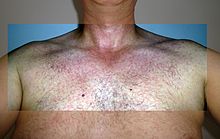The Zika virus is the cause of Zika fever, a mosquito-borne infection found in various tropical areas. The disease can severely damage children in the womb, although it is not otherwise remarkably severe for most people. Also sexual partners to a woman who might be or later get pregnant should take precautions.
Many governments recommend that women who are or might become pregnant should avoid travel to areas where Zika is a risk, and some (Colombia, the Dominican Republic, Ecuador, El Salvador, Jamaica and the Philippines as of early 2016) are recommending that their residents postpone pregnancy.
According to the World Health Organization in 2024:
- "Cases of Zika virus disease declined from 2017 onwards globally; however, Zika virus transmission persists at low levels in several countries in the Americas and in other endemic regions. To date, a total of 89 countries and territories have reported evidence of mosquito transmitted Zika virus infection, however surveillance remains limited globally. No vaccine is yet available for the prevention or treatment of Zika virus infection."
Locations
[edit]
Until about 2007, this was a rare disease and geographically confined to a few parts of Africa and Asia. However, since then it has spread and by 2015 it reached epidemic levels in much of South America, Central America and the Caribbean. In February 2016, the World Health Organization (WHO) declared this an international health emergency. In the Western Hemisphere the disease has spread to Florida with several autochthonous cases in the Miami region. In August and September 2016, several hundred locally transmitted Zika infections were reported in Singapore, though as of early November there are just a few new infections every week.
Zika is also fairly common throughout Southeast Asia and occurs in parts of Africa, South Asia, and the Pacific islands, including Hawaii.
Even in Zika-infected parts of the world, Zika is much less of a risk at higher altitudes, defined as 2000 m or 6500 ft above the sea level where the aedes aegypti mosquito spreading the disease doesn't "usually" exist.
Symptoms and treatment
[edit]
Only about one person in five infected with the virus develops symptoms. For those that do, Zika is generally a fairly mild infection, about like a flu, often with a fever, a rash and/or inflammation of the eyes. Symptoms typically last less than a week, and the disease very rarely kills.
Zika infection in pregnant women has been linked to congenital deformities and developmental disorders, most notably microcephaly, meaning that a baby is born with a much smaller brain than normal and severely impaired intellectual ability.
There is no vaccine, no drug that prevents infection, no cure other than waiting it out, and no treatment that will eliminate the virus. All the doctors can do is advise rest and fluids, and possibly prescribe drugs for the pain and fever.
If you suspect a Zika infection, see a doctor rather than self-medicating. Zika is easily confused with Chikungunya or with dengue fever, diseases caused by related viruses carried by the same genus of mosquito, with similar symptoms and a similar geographic distribution. If what you have is dengue, then taking some common over-the-counter medicines such as aspirin and ibuprofin will increase the risk of dangerous complications.
Zika is transmitted mainly by mosquitoes, but it can also be transmitted mother-to-child in the womb and man-to-woman during sex. It is not known whether other sexual transmission is possible.
Precautions
[edit]Even for pregnant women, Zika is not yet at the critical warning level. CDC use a three-point scale for their warnings:
- 1 take normal precautions
- 2 avoid travel if possible & take enhanced precautions if you do go
- 3 avoid all non-essential travel
As of mid-2016, Zika is only at Level 2. Enhanced precautions for Zika mean taking great care to avoid mosquito bites — screened windows, mosquito nets, clothing that covers most of your skin, permethrin treatment for clothing and gear, and insect repellents. Sexual partners to a woman who might be or later get pregnant should take the same precautions, and men who might have got the infection (whether or not they have had symptoms) should use condoms to avoid transmitting the virus, for a time of six months.
When the government of a thoroughly Catholic country starts handing out free condoms — as Colombia did, both for locals and at the airport for visitors arriving for 2016 Carnivale — it is clear that they take the threat very seriously indeed.
More information
[edit]Three sources for extensive information on Zika are:
- The US government Center for Disease Control (CDC) Zika website
- The World Health Organization (WHO)
- Health Canada
The CDC has a map showing Zika risk in various countries.

